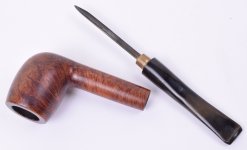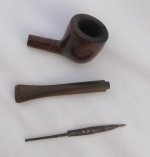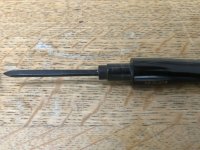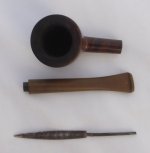And roughly as useful as most I’ve seen on Kaywoodies and Linkman’s for moisture control. ?Totally redefines the term "stinger".
Pipe Dagger
- Thread starter The Mitre
- Start date
You are using an out of date browser. It may not display this or other websites correctly.
You should upgrade or use an alternative browser.
You should upgrade or use an alternative browser.
SmokingPipes.com Updates
Watch for Updates Twice a Week
How come?? It's got a helluva more surface for condensation!And roughly as useful as most I’ve seen on Kaywoodies and Linkman’s for moisture control. ?
The first thing I thought of when I saw the three holes was for blood letting.As promised here are the images of the "dagger" removed from the shaft. as you can see it's made in one piece. I wonder why the three holes are there, maybe like the grooves on a sword, makes it easier to get out!!
The image in the middle is a confirmed Dr Plum dagger pipe.
View attachment 147828View attachment 147829View attachment 147830
Having seen many similar looking ones over the years, I'd have to agree. That's just a stinger.I have a Kaywoodie with a three hole assassins attatchment.
Sometimes, a stinger is just a stinger.
Here's a genuine SOE pipe from WW2, complete with the ensconced blade.
 They also used to conceal similar looking blades in pencils, razors etc. An inventive bunch of chaps ( & chapesses don't forget) were the SOE!
They also used to conceal similar looking blades in pencils, razors etc. An inventive bunch of chaps ( & chapesses don't forget) were the SOE!Not good for rope tobacco or plugs ??? ?A dead giveaway as a weapon, as its design is so different to the usual slender stemmed ones
Any samurai carrying that might as well have "assassin" tattooed on his forehead. ?
I'm writing a book and part of the information I possess will be written into that book, so I don't want to go into excessive detail on the forum, but in his memoire Christopher Clayton-Hutton (the inspiration for James Bond's "Q") conceived of the idea of secreting articles to help WWII POWs escape in 1940-41 and began custom-ordering these items having secret compartments, pipes among them, in Fall 1941. To identify the pipes and not have them confused with normal pipes, there were unique "models" made beginning with certain letters and intelligence to that extent was forwarded accordingly. Thus if you're certain the model is a 1937 and a regular production item, I'd have to agree with Simon in his assessment: sometimes a stinger is just a stinger. Also, it needn't be WWII era if it is in fact a weapon.Having seen many similar looking ones over the years, I'd have to agree. That's just a stinger.
Here's a genuine SOE pipe from WW2, complete with the ensconced blade.
They also used to conceal similar looking blades in pencils, razors etc. An inventive bunch of chaps ( & chapesses don't forget) were the SOE!
Wasn't that from WWII for OSS and that British org. who's name seems to skip my mind currently. SOE.
Ok guys thanks for all that. I'm convinced it's not a stinger so I'll list it on eBay over the weekend and let the market decide.
If I get any more weir and wonderful pipes I'll be back on the forum
If I get any more weir and wonderful pipes I'll be back on the forum
those holes or channels aren't for blood. They reduce the weight or the material used without significantly compromising the strength of the blade. These holes could be something like that, wouldn't do anything for blood.The first thing I thought of when I saw the three holes was for blood letting.
Thank you for that. You learn something new every day, I guess. I found this after reading your post. In the '60s or '70s, shopping for militaria with my older brother, I remember the grooves in WWII bayonets being referred to as "blood runners."those holes or channels aren't for blood. They reduce the weight or the material used without significantly compromising the strength of the blade. These holes could be something like that, wouldn't do anything for blood.
what in the making of it?The holes are like tear drop tats. They mark the number of kills
people call them things like that but in a bayonet it was to keep it from being top heavy which would mess up accuracyThank you for that. You learn something new every day, I guess. I found this after reading your post. In the '60s or '70s, shopping for militaria with my older brother, I remember the grooves in WWII bayonets being referred to as "blood runners."
I like the weight theory. Make the blade, lighten it and then temper the steel, it's a sharp little devil....










